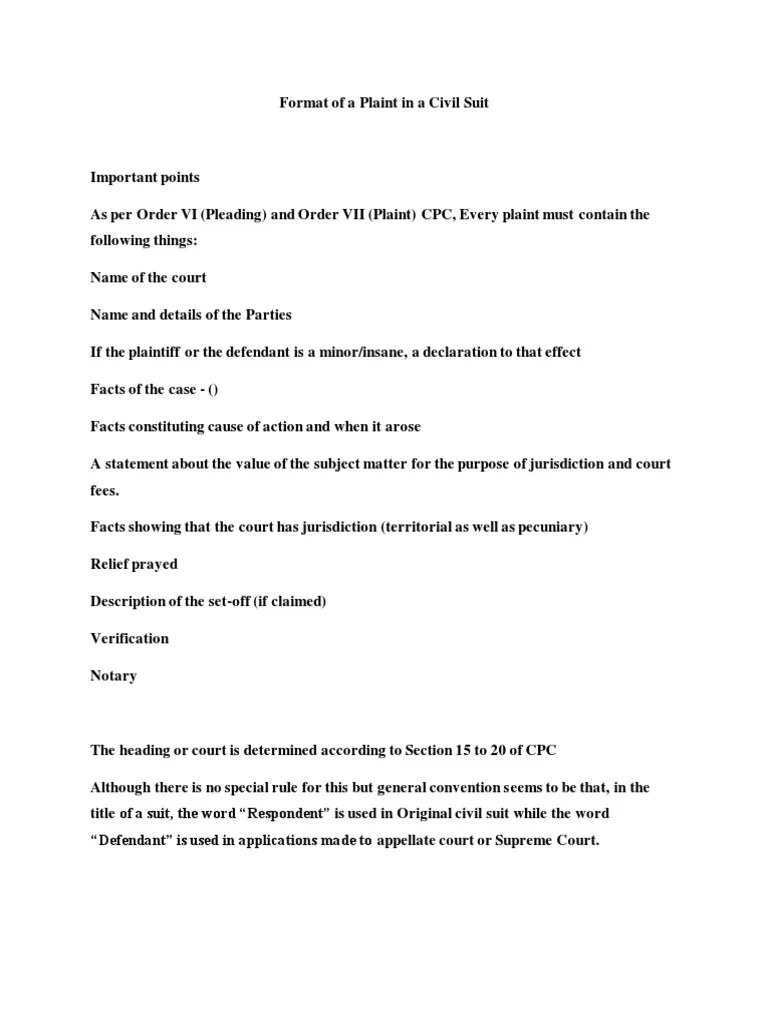Navigating the Civil Case Drafting Format: A Comprehensive Guide
Civil lawsuits necessitate meticulous attention to detail and a methodical writing process. Understanding the format for drafting civil cases is essential for making a convincing argument and guaranteeing a clear and succinct presentation of your client’s position, regardless of whether you are a lawyer, paralegal, or otherwise involved in the legal profession. The fundamental components of writing a civil case, from the initial complaint to the final judgement, will be discussed in this article.

Pleadings include the following:
A. Complaint, which introduces the civil case and outlines the plaintiff’s claims against the defendant. It should contain a succinct summary of the relevant facts, the legal foundation for the assertion, and the requested remedy. Start with a caption that includes the parties’ names, the case number, and the name of the court.
B. The defendant’s answer to the complaint is referred to as the answer. Each charge presented by the plaintiff is addressed, and affirmative defences and counterclaims may be included. In the response, specific complaints should be admitted or denied, along with any extra material that may be required. It should be well-organized and responsive.
C. Reply (if necessary): In certain jurisdictions, a plaintiff may submit a reply in order to address any new points made by the defendant in their answer.

Collection of 10000+ Legal Drafts, Legal Notices, Pleadings, etc. All the Drafts are 100% ACCURATE and EDITABLE as per your requirement.
Legal briefs and motions:
A. A motion is a formal request to the court for a certain remedy or course of action. requests to dismiss, requests for summary judgement, and motions to compel discovery are examples of common motion types in civil proceedings. Each motion should contain a succinct summary of the legal grounds, a defence, and any pertinent exhibits or evidence.
B. motion or legal brief may be accompanied by a memorandum of law. Citing pertinent statutes, case law, and legal precedents, it offers a thorough explanation of the legal concerns. A persuasive memorandum of law helps your client convince the judge of their case.
C. Legal Brief: A legal brief gives a thorough defence of a particular legal contention. It should contain a succinct assessment of the matter, a rundown of pertinent facts, a legal analysis, and a strong argument in favour of your client’s position. A well-written legal brief must adhere to proper formatting, have distinct headings, and be logically organised.

Interrogatories are written inquiries one party sends to another in an effort to learn more about the case. Every interrogatory must be precise, straightforward, and pertinent to the disagreement.
Requests for Document Production: A party may ask the other party to provide pertinent records or other evidence in the case. Include a clear description of the documents or categories of records you are seeking, as well as a deadline for compliance.
Depositions: Sworn testimony provided outside of court by parties or witnesses is referred to as a deposit. The transcripts of depositions can help with trial preparation and evidence presentation.
civil case drafting format Kit
Documents used before and during a trial include: a. Pre-Trial Statements, which lay out each party’s views, witnesses, exhibits, and anticipated legal challenges. It aids in the understanding of the case’s scope by the court and the opposing parties and gets them ready for the forthcoming hearings.
a. Trial Brief: The evidence and legal arguments that will be submitted at trial are summarised in a trial brief. Each aspect of the claims or defences should be covered, and the most important legal arguments in favour of your case should be highlighted.
b. Proposed Findings of Fact and Conclusions of Law: To help the court decide the case, parties may be required in some jurisdictions to make proposed findings of fact and conclusions of law. These texts offer recommendations for the court’s ruling based on a synopsis of the relevant facts and legal contentions.
c. Judgement: The judgement is the court’s ruling on the case’s merits and is the last document in a civil lawsuit. It ought to be very clear about the remedy that has been granted or denied as well as the court’s factual and legal judgements.
Conclusion: civil case drafting format
In order to properly support your client’s viewpoint and provide a persuasive argument, you must design a civil case using a methodical and planned methodology. You can improve your capacity to negotiate the legal system and present a persuasive case by comprehending the framework for preparing civil cases and combining the key components covered in this article. Keep in mind that effective writing is essential to persuading the court, influencing the result, and protecting your client’s interests.
